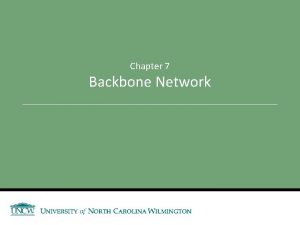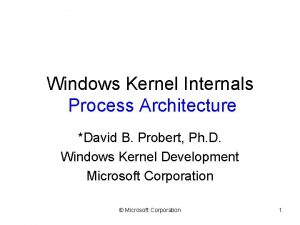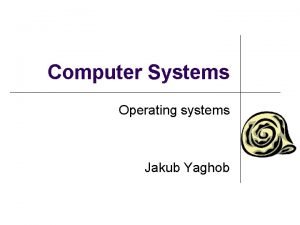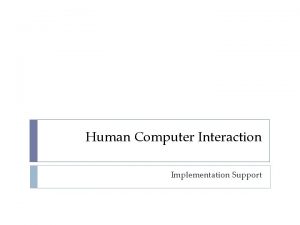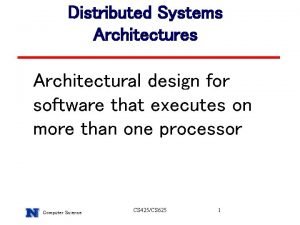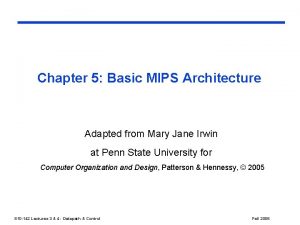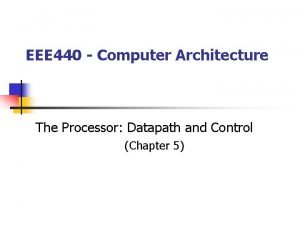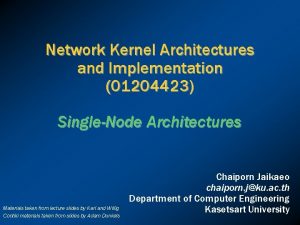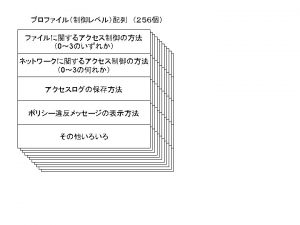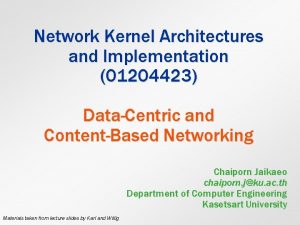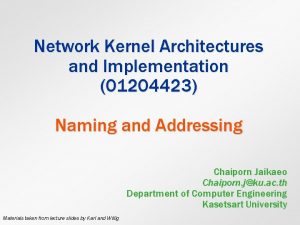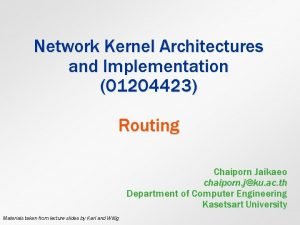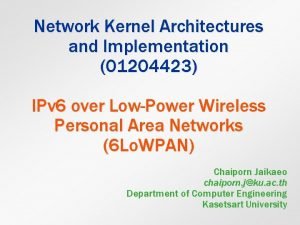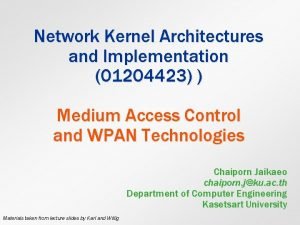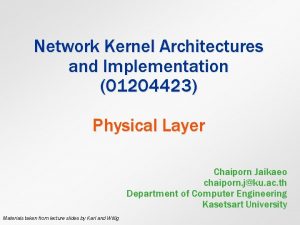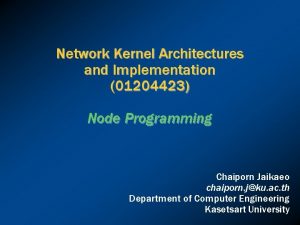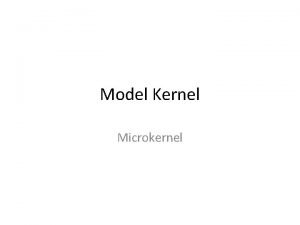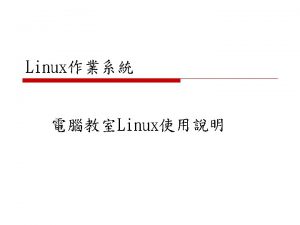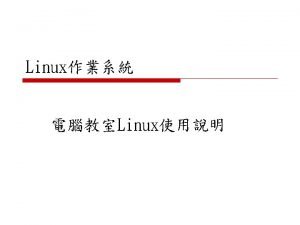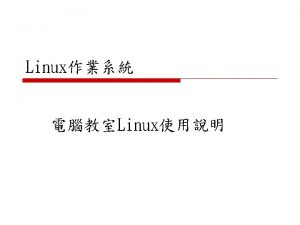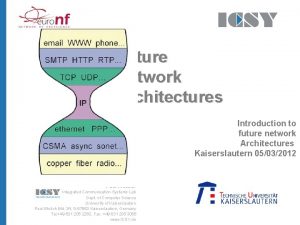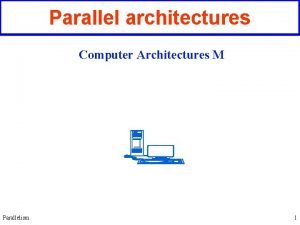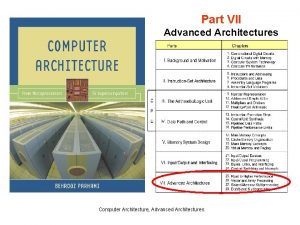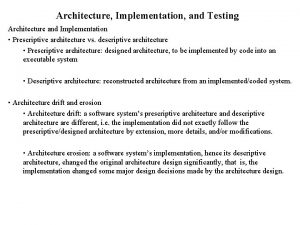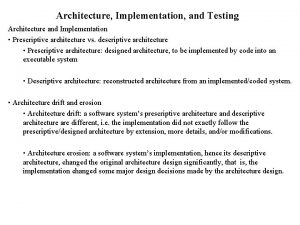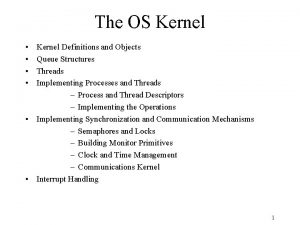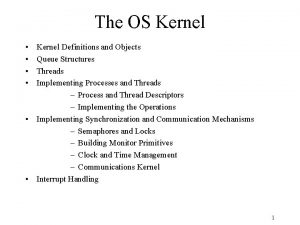Network Kernel Architectures and Implementation 01204423 Network Architecture

























- Slides: 25

Network Kernel Architectures and Implementation (01204423) Network Architecture Chaiporn Jaikaeo chaiporn. j@ku. ac. th Department of Computer Engineering Kasetsart University Materials taken from lecture slides by Karl and Willig

Outline l l Network scenarios Optimization goals Design principles Gateway concepts 2

Typical Views of WSN l l l Self-organizing mobile ad hoc networks (MANETs) Peer-to-peer networks Multi/mobile agent systems and swarm intellegence 3

Sensor Network Scenarios l l Sources: Any entity that provides data/measurements Sinks: Nodes where information is required Source Sink Internet 4

Single-Hop vs. Multi-hop l Multi-hop networks Ø Ø Ø l Send packets to an intermediate node Intermediate node forwards packet to its destination Store-and-forward multi-hop network Store & forward multi-hopping NOT the only possible solution Ø E. g. , collaborative networking, network coding Sink Source Obstacle 5

Multi-hopping Always Efficient? l Obvious idea: Multi-hopping is more energyefficient than direct communication Ø Ø Suppose we put a relay at distance d/2 Energy for distance d is reduced from cd to 2 c(d/2) § § l c - some constant - path loss coefficient ( 2) Usually wrong, or over-simplified Ø Need to take constant offsets for powering transmitter, receiver into account 6

Multiple Sinks, Multiple sources 7

Outline l l Network scenarios Optimization goals Design principles Gateway concepts 8

Goal: Quality of Service l Qo. S in WSN is more complicated (compared to MANET) Ø Ø Ø l Event detection/reporting probability Event classification error, detection delay Probability of missing a periodic report Approximation accuracy (e. g, when WSN constructs a temperature map) Tracking accuracy (e. g. , difference between true and conjectured position of the pink elephant) Related goal: robustness Ø Network should withstand failure of some nodes 9

Goal: Energy efficiency l Many definitions Ø Ø Energy per correctly received bit Energy per reported (unique) event Delay/energy tradeoffs Network lifetime § § § Time to first node failure Network half-life (how long until 50% of the nodes died? ) Time to partition Time to loss of coverage Time to failure of first event notification 10

Sharpening the Drop l Sacrifice long lifetimes in return for an improvement in short lifetimes 11

Outline l l Network scenarios Optimization goals Design principles Gateway concepts 12

Distributed Organization l WSN participants should cooperate in organizing the network Ø l Potential shortcomings Ø l Centralized approach usually not feasible Not clear whether distributed or centralized organization achieves better energy efficiency Option: “limited centralized” solution Ø Ø Elect nodes for local coordination/control Perhaps rotate this function over time 13

In-Network Processing l WSNs are expected to provide information Ø Ø l Gives additional options E. g. , manipulate or process the data in the network Main example: aggregation Ø Ø Ø Apply aggregation functions to a collection tree in a network Typical functions: minimum, maximum, average, sum, … Not amenable functions: median 14

Aggregation Example 1 1 3 1 1 6 1 1 15

Signal Processing l l Another form of in-network processing E. g. , Ø Ø l Exploit temporal and spatial correlation Ø Ø l Edge detection Tracking/angle detection of signal source Observed signals might vary only slowly in time Signals of neighboring nodes are often quite similar Compressive sensing 16

Adaptive Fidelity l l Adapt data processing effort based on required accuracy/fidelity E. g. , event detection Ø l When event occurs, increase rate of message exchanges E. g. , temperature Ø Ø When temperature is in acceptable range, only send temperature values at low resolution When temperature becomes high, increase resolution and thus message length 17

Data Centric Networking l Interactions in typical networks are addressed to the identities of nodes Ø l In WSN, specific source of events might not be important Ø l Known as node-centric or address-centric networking paradigm Several nodes can observe the same area Focus on data/results instead Data-centric networking Ø Principal design change 18

Implementation Options l Publish/subscribe (NDN – Named Data Networking) Ø Ø l Nodes can publish data, can subscribe to any particular kind of data Once data of a certain type has been published, it is delivered to all subscribers Databases Ø SQL-based request 19

Outline l l Network scenarios Optimization goals Design principles Gateway concepts 20

Gateways in WSN/MANET l l Allow remote access to/from the WSN Bridge the gap between different interaction semantics Ø l E. g. , data vs. address-centric networking Need support for different radios/protocols 21

WSN tunneling l Use the Internet to “tunnel” WSN packets between two remote WSNs Internet Gateway nodes Gateway 22

6 Lo. WPAN l l l IPv 6 over Low-power Wireless Personal Area Networks Nodes communicate using IPv 6 packets An IPv 6 packet is carried in the payload of IEEE 802. 15. 4 data frames 23

Example 6 Lo. WPAN Systems 24

Summary l l Network architectures for WSNs look quite different from typical networks in many aspects Data-centric paradigm opens new possibilities for protocol design 25
 Switched backbone
Switched backbone Backbone network architectures
Backbone network architectures Windows kernel architecture
Windows kernel architecture Windows kernel architecture
Windows kernel architecture Database storage architecture
Database storage architecture Autoencoders, unsupervised learning, and deep architectures
Autoencoders, unsupervised learning, and deep architectures Kernel network
Kernel network Implementation support and interface architecture in hci
Implementation support and interface architecture in hci Integral product architecture example
Integral product architecture example Ansi sparc
Ansi sparc Theo schlossnagle
Theo schlossnagle Modular vs integral product architecture example
Modular vs integral product architecture example Gui architectures
Gui architectures Database system architectures
Database system architectures Cdn architectures
Cdn architectures Aaron bannert
Aaron bannert Three tier data warehouse
Three tier data warehouse What is isa in computer architecture
What is isa in computer architecture Client server in e-commerce
Client server in e-commerce Banking system architecture diagram
Banking system architecture diagram Cache coherence for gpu architectures
Cache coherence for gpu architectures Why systolic architectures
Why systolic architectures Network design and implementation
Network design and implementation Basic mips implementation in computer architecture
Basic mips implementation in computer architecture Datapath in computer architecture
Datapath in computer architecture Enterprise network implementation
Enterprise network implementation

